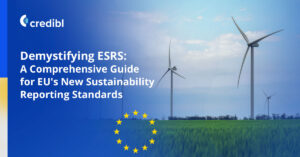The Global Pandemic emphasized the significance of Environmental, Social, and Corporate Governance factors in capital markets, which increased the demand for ESG investing and the potential for significant investment outcomes.
ESG reporting includes information about a company’s carbon footprint, diversity and inclusion practices, executive compensation, and more. This information can help investors evaluate a company’s sustainable risks and potential for long-term growth.
Here is a list of reasons why ESG Reporting is Important in Portfolio Management:
- Identify your ESG Prospects with more Precision
Measure the potential for ESG improvement opportunities based on Environmental, Social, and & Economic dimensions, and establish performance objectives accordingly. - Compare ESG Performance against Industry Standards
Assess your ESG performance against industry baselines to uncover your strengths and pinpoint areas for improvement. - Evaluate Company-level Contribution to your overall ESG Performance
Gain detailed insights into top and bottom performers, as well as your largest holdings, through a series of company ranking tables. - Mitigate the Compliance Risks
Companies that fail to address ESG risks may face reputational damage, legal liabilities, and regulatory fines. By incorporating ESG reporting into their investment analysis, investors can identify and manage these compliance risks more effectively. - Regulatory Requirements
ESG disclosure regulations such as SASB, TCFD, and GRI are increasingly being implemented by regulators worldwide. Likewise, The EU Sustainable Finance Disclosure Regulation (SFDR) mandates that asset managers disclose their approach toward integrating ESG factors in investment decisions. - Asset Decarbonization
Our portfolio-alignment tool enables financial institutions to finance and monitor heavy emitters only when the funds are utilized for responsible retirement or decarbonization of the emitting assets, with a pre-defined target for each portfolio company.
To sum up, portfolio alignment can help financial institutions manage compliance risks by identifying companies that fail to address ESG risks, mitigating reputational damage, legal liabilities, and regulatory fines. Additionally, portfolio alignment can facilitate meeting regulatory requirements for ESG disclosure, allowing financial institutions to stay competitive in the market.
Credible Platform provides Portfolio Optimization along with GRI and TCFD framework reporting. We use a robust methodology to evaluate ESG factors that influence company value drivers, such as growth, profitability, capital efficiency, and risk exposure. By prioritizing ESG considerations, investors can manage risks, generate higher long-term returns, and satisfy client demand. This can contribute to reducing the carbon footprint and promoting sustainability in the long run.
Connect with our ESG portfolio specialist to know more about how to integrate ESG Data Management and Reporting into your core business strategy.







